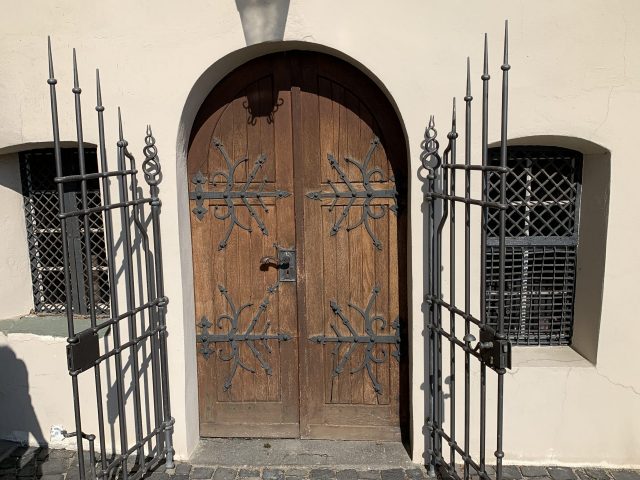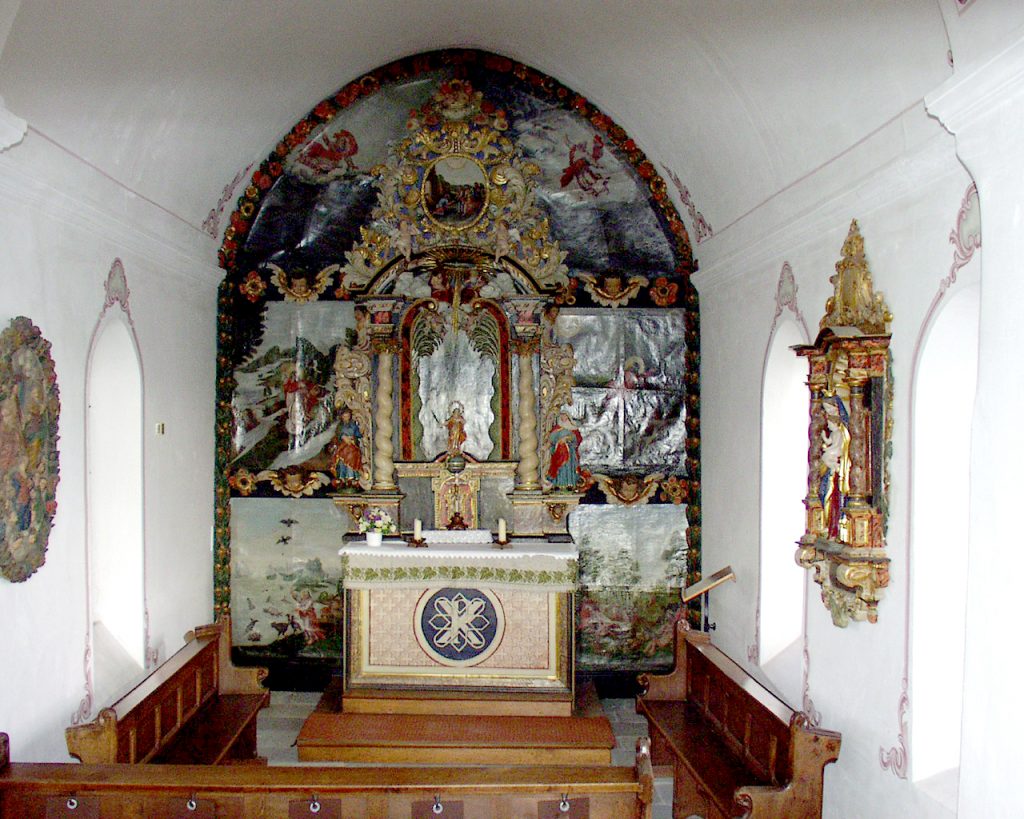Holy Trinity Chapel
In the southeast of the Lubentius church the Holy Trinity chapel is located.

Entrance to the Holy Trinity Chapel.
It is first mentioned on 8 February 1378 in a testament of Canonicus Johannes von Attendorn. In a second testament dated 02 July 1387 he writes that he had built an extension which was located east of the sacristy base.
The west side was closed with a wall, the closing wall received a door and 2 small windows. The space thus obtained was consecrated to the Holy Trinity. It was not until 1334 that the Trinity Festival, which is celebrated on the first Sunday after Pentecost, was officially introduced by the Pope John XXII for the whole church, before that, it probably was only celebrated in monasteries.
The ceiling is a stuccoed wooden barrel ceiling.
Under Canonicus priest Caspar Schorn the room of the Trinity Chapel received its baroque character. In 1699 the Canonicus priest Caspar Schorn (1683 -1702) donated the baroque altar which still exists today. The carvings of the altar were made by Christian Diezer and Johan Neudecker (Johann Valentin Neudecker the Elder) from Hadamar. The paintings of the six daily works of God (creation of the earth) and the portrait of God’s promise to Abraham about his son Isaac were created by the Limburg painter Jacob.

According to https://denkxweb.denkmalpflege-hessen.de/52860/ the altar and the works of art in the chapel are described as follows:
The main figure of a Maria Immaculata in the middle of a palm grove is surrounded by the side figures of St. Joachim and St. Anna and the Holy Ghost Dove hovering above. The high extension, decorated with luxuriant acanthus leaves, surrounds an oval picture announcing the birth of a son to Abraham. All the rest of the east wall is taken up by six large oil paintings depicting the creation of the world. On the north wall is a coloured relief from around 1730: Mary and Christ implore forgiveness for sinful humanity. On the south side reredos from the end of the 17th century with later ornamental decoration from around 1730 and 1760, in the central niche a modern figure of the Virgin Mary. In the centre of the ceiling a vault small round painting of the Holy Trinity, late 19th century.

Inside the room, under a large stone slab, there is a baroque tomb attributed to the founder of the baroque altar. According to W.H. Struck in DAS STIFT ST. LUBENTIUS IN DIETKIRCHEN, S 31/32 the chapel contains the following graves:
Cantor J. K. Vosbein (1731 – † 1796), secretary of the monastery from 1788 – 1791
Cantor Ph. F. Hermes († 1806), secretary of the monastery from 1792-1801
Canon A. Knecht († 1658)
Canon C. Schorn († 1702)
Canon F. F. J. Carove († 1799)
Canon K. J. Flörchinger († 1807)
Vicar J. G. Petri († 1772)
Vicar J. H. Hoefer († 1799)
According to Struck, it is also written in the church book on the anniversary of J.K. Vosbein’s death that all canons are to be buried in the Holy Trinity Chapel in the future. The grandmother of dean H. Distel (1670 – † 1740), Dorothea Müller, born Gorgendiell († 1703), was also buried in the chapel. Struck also explains that only the gravestones of C. Schorn and J.G. Petri (also written Petry) still exist. Between the two gravestones there is said to be a third one, but its inscription is no longer legible. The only preserved feature on this unreadable gravestone is a coat of arms with a stake ending in an arrow at both the top and bottom. The stake is crossed by a beam, the upper right end of which merges into a loop and the lower left end into a hook.
The gravestone of C. Schorn is made of grey basalt. Struck describes his grave as follows:
Under a chalice in the laurel wreath with the host above it the coat of arms surrounded by palm fronds (a similar coat of arms exists on the organ):
divided by a beam and a thread, from which two arches branch off above the beam, in the six fields thus formed C S at the top, C P in the middle, S L at the bottom (Caspar Schorn, canonicus pastor sancti Lubentii.
Under the coat of arms the inscription:
ANNO 1702 DIE XXV MENSIS JUNY ADMODUM REVERENDUS DOM(INUS) CASPARUS SCHORN MONASTERIO EIFFLIACUS QUI CUM PER XXV ANNOS HUIUS ECCLESIAE CANONICUS CAPITULARIS ET PER XVII(!) ANNOS EXTITISSET PASTOR SEDULUS SUASQUE OVES SOLLICITE PAVISSET NECNON AD MAIOREM DEI GLORIAM HOC SACELLUM DECORASSET MAGNO SUI APUD PAROCHIANOS RELICTI DESIDERIO AETATIS SUAE ANNO 49 PIE OBDORMIVIT
IN DOMINO CUIUS ANIMA REQUIESCAT IN PACE AMEN.
In the time of C. Schorn, a pilgrimage to the Chapel of the Holy Trinity is said to have brought the pilgrim a plenary indulgence approved by Rome. The number of communicants increased from 500 in 1683 to about 2000 in 1699. Dean Distel also reports from the period after 1711 that a plenary indulgence is granted on the feasts of St Trinity and St Lubentius in the collegiate church. In 1711, Dean Heinrich Tripp had the document granting indulgences for the two feast days mentioned renewed by Rome. Even after 1721, Dean Distel reports that the number of communicants on the feast of St. Trinitatis was sometimes over 3000 communicants. For 1786 a bill even proves the purchase of 5000 consecrated wafers and the hosting of 6 confessors for the feast of the Holy Trinity.
